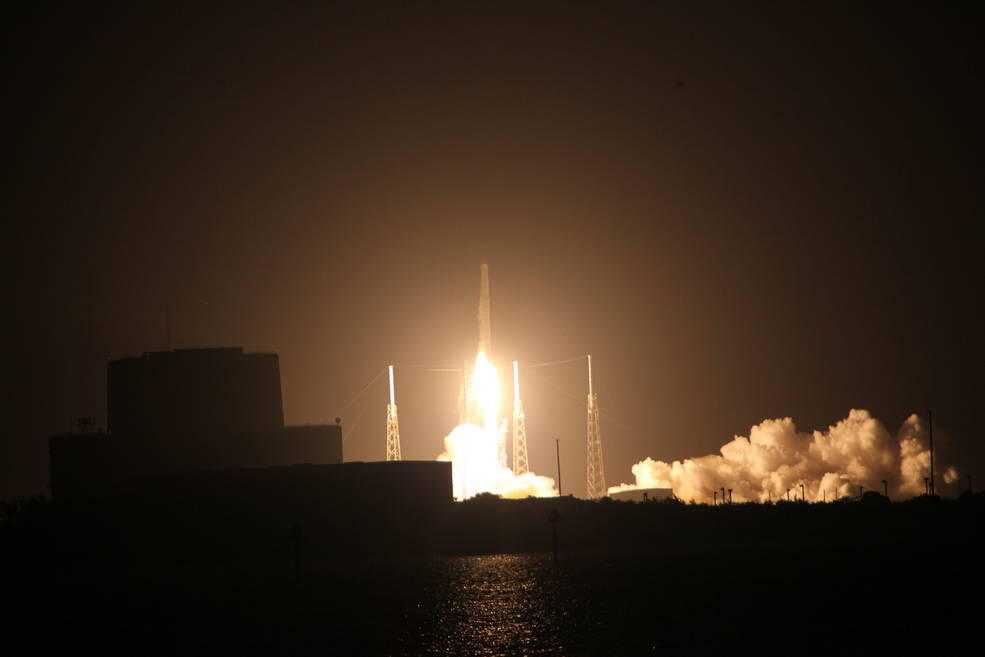Astronauts aboard the International Space Station can expect almost 5,000 pounds of new hardware and experiments in two days following Monday’s early-morning liftoff of a SpaceX Falcon 9 rocket and Dragon spacecraft. The launch lit up the skies over Florida’s Atlantic coast at 12:45:29 a.m. EDT as the nine engines of the Falcon rocket ignited to push the stack away from its launch pad and place the Dragon on a course to catch up to the station in two days.
Packed tightly inside the unpiloted Dragon spacecraft are a host of supplies for the station crew along with critical materials for dozens of the more than 250 scientific investigations slated to take place during the next several months. As an orbiting laboratory, the space station offers a unique platform to conduct research focused on improving aspects of life on Earth, decoding the challenges of long-duration spaceflight for astronauts traveling to deep-space in the future and for monitoring global changes on our home planet.
Dragon also carries a component for the station that will set it up for a new era of human spaceflight: international docking adapter, or IDA. The hardware is a ring weighing more than 1,000 pounds that will provide a standardized connection point to the station for visiting spacecraft including the Boeing CST-100 Starliner and SpaceX Crew Dragon, both now in development in partnership with NASA’s Commercial Crew Program.
Engineered to an international docking standard and with numerous sensors and instruments attached, the adapter is designed to work with automated guidance systems on arriving spacecraft so they can safely dock to the station with little, if any, involvement from the crew in the spacecraft. The station’s robotic arm will retrieve the IDA from the unpressurized trunk of the Dragon and spacewalkers will complete the installation of the adapter in August.
The rest of the cargo, including the research payloads, is riding inside the Dragon’s pressurized compartment. Once berthed to the station, the Dragon’s hatch will be opened so station crew members can move inside to gather the supplies.
One of the scientific projects is the work of high school students in Eagleton, Colorado. As part of NASA’s HUNCH program, which stands for High Schools United with NASA to Create Hardware, students created an experiment to help reveal how nano-scale structures can be created. The experiment will see how silver crystals form wires as small as one atom wide. Crystals can form larger structures in microgravity because they don’t collapse under their own weight.
Housed inside a NanoRacks NanoLab, the experiment will be performed in a very small box about 4x4x6 inches. It is an automated experiment that astronauts will click into place and let run for about four weeks. Then they will unplug the box and pack it in foam inside the same Dragon capsule for the return to Earth.
“They’ve come up with a novel way to do this and see how the nano crystals will form in microgravity compared to here on Earth,” said Mary Murphy, senior internal payloads manager for NanoRacks. “They want to see if they can better understand how the structures are formed in order to find is a better way to produce structures on the ground.”
The experiment was the last of the HUNCH projects to be evaluated aboard NASA’s zero-gravity aircraft – the “vomit comet” – before the research was assigned to fly to the space station. The aircraft testing offered about 30 seconds of weightlessness at a time compared to the around-the-clock microgravity conditions of the station.
“It’s very special when students get to have experiments tested on the International Space Station,” said Abby Dickes, manager of Creative and Strategic Planning for DreamUp, the organization that helps coordinate student-performed research efforts via launch services provider, NanoRacks. “The students are some of the most exciting researchers to work with- the passion to see their experiment succeed is contagious, and together, we are making a difference for the future of space exploration.”
Dragon also carries TangoLab-1, which is a sophisticated rack equipped with the infrastructure researchers need to conduct experiments inside the station. The TangoLab is the product of a Kentucky-based company called Space Tango that was built on the experiences of engineers who designed and flew CubeSats and space station experiments. With high demand to perform research in orbit, the company’s CEO, Twyman Clements, said the rack is designed to be flexible to many fields of science. Once in place aboard the station, the TangoLab will remain while the individual experiments – up to two dozen at a time – are traded out as new resupply missions arrive.
“It’s plugged into the station’s network for data transfer and it’s reconfigurable so we can do experiments from about the size of a tissue box to research that would take up the entire rack,” Clements said.
An experiment called ACES-T1, for Advanced Colloids Experiment – Temperature control-1, also will examine micro-sized structures and how they form. Researchers want to see how the molecules form themselves into shapes and formats free from gravity.
Astronauts on the station will set up the new experiments and equipment inside the station’s facilities and return trash, completed research and unneeded equipment to the Dragon. After five weeks in orbit, the Dragon will detach and steer itself back through Earth’s atmosphere to land in the Pacific Ocean under a parachute.
Source: NASA











